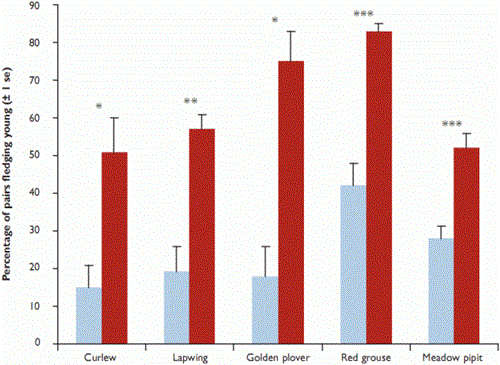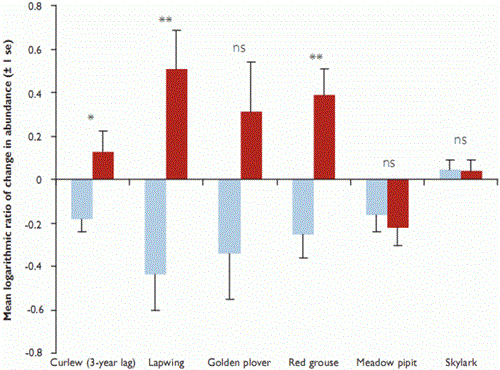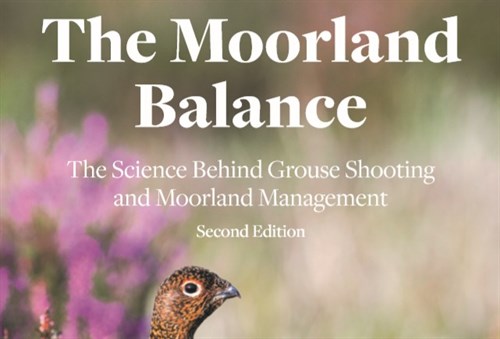The Upland Predation Experiment based at Otterburn in Northumberland aimed to test whether predator removal by moorland gamekeepers (ie. killing foxes, crows, stoats and weasels) improved breeding success and abundance of moorland birds. Species of conservation concern in the UK, such as curlew, lapwing, red grouse and skylark, are of particular interest. The project area consisted of four plots, each about 1,200 hectares, on which bird numbers and their breeding success were monitored between 2000 and 2008.
There were two long-term plots that remained under the same regime for the duration of the project (Plot C had predator control; Plot D no predator control). The other two plots were switched over, so that Plot A had a full-time keeper from autumn 2000 to autumn 2004, and Plot B was the unkeepered comparison. In the autumn of 2004, predator control started on Plot B and stopped on Plot A. The switchover allows us to look at breeding success and abundance on the same plot with and without predator removal.
The predator abundance indices, collected separately from the keepering activities, show significant reductions in spring abundance for foxes (-43%) and carrion crows (-78%). For the small mustelids, spring weasel abundance was at a low level on plots with and without predator removal (7-8% of tracking tunnels found with footprints) and stoat abundance was too low to allow us to look at trends in abundance. Extensive collection of vegetation parameters allows us to be confident that plot-years with and without predator removal did not differ in habitat. So any differences found in the ground-nesting birds were because of the predator removal treatment alone.
Figure 1: Breeding success of ground-nesting birds monitored as part of the Upland Predation Experiment after controlling for site and year effects

As of June 2009, the lapwing is red listed and the remaining species in this graph are amber listed in the UK’s list of species of conservation concern.
The breeding success of some species was significantly improved with predator removal (see Figure 1). For lapwing, golden plover, curlew, red grouse and meadow pipit, on average a three-fold improvement was seen, from 23% of pairs fledging young without predator removal to 64% of pairs fledging young with predator removal. Although similar trends showing improved breeding success were seen for black grouse and grey partridges, these species were only found on two plots and were not abundant enough to allow robust analysis.
An improvement in breeding success may lead to a subsequent improvement in the number of breeding birds, assuming that the young produced breed close to where their parents bred. Within the Upland Predation Experiment we analysed the trends in breeding abundance considering the annual change in abundance from one year (year 0) to the next (year 1) in relation to the predator removal treatment in year 0 for species that can breed when a year old. We considered a three-year lag for curlew as this species normally returns to breed when three years old. For all the wader species (curlew, golden plover, lapwing, we found increases in abundance with predator removal (mean annual change +37%) and decreases in abundance with no predator removal (mean annual change -28%), but the changes in abundance were statistically significantly different only for curlew (with a three-year lag) and lapwing (see Figure 2). Although red grouse also showed a significant difference (+47% annual change with predator removal, -22% annual change without predator removal), no such differences were detected in meadow pipit and skylark (see Figure 2).
Figure 2: Changes in abundance of ground-nesting birds monitored as part of Upland Predation Experiment after controlling for site and year effects

The horizontal line is the line of no change in breeding abundance.
*, **, *** = levels of significance; ns = not significant.
As of June 2009, the lapwing and skylark are red listed and the remaining species in this graph are amber listed in the UK’s list of species of conservation concern.
This project highlights the benefits that predator removal can provide on moorland for bird species of conservation concern; providing clear evidence for us to show land managers and policy makers.
This work was published in 2010 within the Journal of Applied Ecology 47: 263-272 (abstract) and is set in context within the UK by Dr Stephen Tapper in the policy document entitled Waders on the Fringe.
Practical advice on predator removal techniques can be found via the GWCT advisory service and our predation control research team.
Acknowledgements
The Upland Predation Experiment would not have been possible without the generous contributions of the Upland Funding Appeal, support from the landowners (Ministry of Defence, Duke of Northumberland, Lord Devonport and Mr Edgar), advice from the Scientific Advisory Committee and the many seasonal staff who helped collect the data.

The Moorland Balance - eBook - only £4.99
Get the science behind grouse shooting and moorland management. Building on the success of the first edition, this new and improved version condenses thousands of pages of scientific literature into easy-to-read questions and answers. Over 200 different studies from across the scientific community are referenced in this 134-page book.
View Book >
or
Buy Now - £4.99 >
100% Secure. All Credit & Debit cards, PayPal, Apple Pay and Google Pay accepted.
